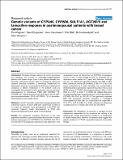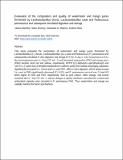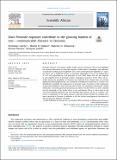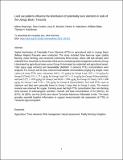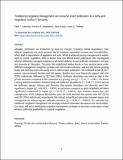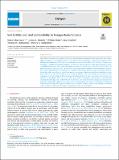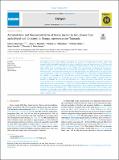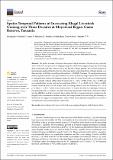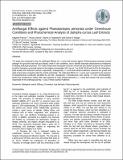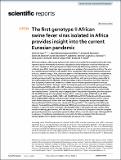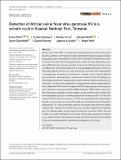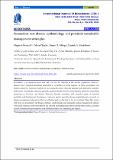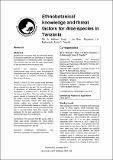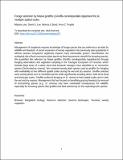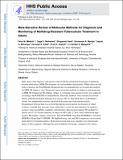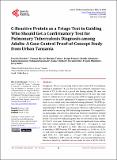Research Articles [LISBE]: Recent submissions
Now showing items 361-380 of 886
-
Genetic variants of CYP3A5, CYP2D6, SULT1A1, UGT2B15 and tamoxifen response in postmenopausal patients with breast cancer
(Springer Nature, 2007-01-23)Introduction Tamoxifen therapy reduces the risk of recurrence and prolongs the survival of oestrogen-receptor-positive patients with breast cancer. Even if most patients benefit from tamoxifen, many breast tumours either ... -
Evaluation of the composition and quality of watermelon and mango juices fermented by Levilactobacillus brevis, Lacticaseibacillus casei and Pediococcus pentosaceus and subsequent simulated digestion and storage
(John Wiley & Sons, Inc., 2022-05-29)This study evaluated the composition of watermelon and mango juices fermented by Levilactobacillus (L.) brevis, Lacticaseibacillus (La.) casei and Pediococcus (P.) pentosaceus and subsequently simulated in vitro digestion ... -
Does Pesticide exposure contribute to the growing burden of non - communicable diseases in Tanzania
(Elsevier B.V., 2022-09)Pesticide exposure is becoming a public health concern in Tanzania. This review highlights the existing information on pesticide exposure, health effects, knowledge, and awareness on pesticide handling and management and ... -
Land use patterns influence the distribution of potentially toxic elements in soils of the Usangu Basin, Tanzania
(Elsevier Ltd., 2021-12)Spatial distribution of Potentially Toxic Elements (PTEs) in agricultural soils in Usangu Basin (Mbeya Region)-Tanzania were conducted. The study included three land-use types (paddy farming, maize farming, and conserved ... -
Traditional rangeland management can conserve insect pollinators in a semi-arid rangeland, northern Tanzania
(Elsevier, 2021-11)Globally, pollinators are threatened by land-use changes, including habitat degradation. East African rangelands are under pressure due to livestock population increase and overutilization, which lead to degradation of ... -
Spatial and seasonal group size variation of wild mammalian herbivores in multiple use landscapes of the Ngorongoro Conservation Area, Tanzania
(PLOS ONE, 2022-04-19)Group sizes of wild herbivores can be indicators of ecosystem health and proxies for individual and population fitness, particularly in areas where human activities have become increasingly common. We recorded 176 single- ... -
Soil fertility and land sustainability in Usangu Basin-Tanzania
(Heliyon, 2021-08-09)Soil fertility determines crop growth, productivity and consequently determines land productivity and sustainability. Continuous crop production exploits plant nutrients from soils leading to plant nutrient imbalance, thus ... -
Rainfall variability and socio‑economic constraints on livestock production in the Ngorongoro Conservation Area, Tanzania
(Springer Nature Switzerland AG., 2021-01-12)Rainfall variability is of great importance in East Africa, where small-scale farmers and pastoralists dominate. Their livestock production activities are heavily dependent on rainfall. We assessed pastoralist perceptions ... -
Accumulation and bioconcentration of heavy metals in two phases from agricultural soil to plants in Usangu agroecosystem-Tanzania
(Heliyon, 2021-07-07)The build-up of heavy metals (HM) in agricultural soils accelerates the HM uptake by plants, which could potentially affect food quality and food safety. Here we studied the status and bioaccumulation of HM from soils to ... -
Spatio-Temporal Patterns of Increasing Illegal Livestock Grazing over Three Decades at Moyowosi Kigosi Game Reserve, Tanzania
(MDPI, 2021-12-02)The global increase of livestock has caused illegal intrusion of livestock into protected areas. Until now, hotspot areas of illegal grazing have rarely been mapped, long-term monitoring data are missing, and little is ... -
Antifungal Effects against Phaeoisariopsis personata under Greenhouse Conditions and Phytochemical Analysis of Jatropha curcas Leaf Extracts
(International Journal of Agriculture and Biology, 2021-07-10)The study was conducted to test the antifungal efficacy of J. curcas leaf extracts against Phaeoisariopsis personata (causal pathogen for groundnut late leaf spot disease) under in vivo conditions, and to identify important ... -
The first genotype II African swine fever virus isolated in Africa provides insight into the current Eurasian pandemic
(Scientific Reports, 2021-06-22)African swine fever (ASF) caused by the African swine fever virus (ASFV) is ranked by OIE as the most important source of mortality in domestic pigs globally and is indigenous to African wild suids and soft ticks. Despite ... -
Environmentally stable common bean genotypes for production in different agro-ecological zones of Tanzania
(Heliyon, 2021-01-19)enotype by environment interaction (GxE) complicates the process of selecting genotypes suitable for quanti tative traits like seed yield in beans, hence slows down the development and release of varieties by breeding programs. ... -
Multilocation dataset on seed Fe and Zn contents of bean (Phaseolus vulgaris L.) genotypes grown in Tanzania
(Elsevier, 2020-05-07)There are over a hundred genotypes of Phaseolus vulgaris L. grown and consumed in Tanzania. Currently, identification of bean genotypes containing high seed iron and zinc contents has been the focus globally for common ... -
Detection of African swine fever virus genotype XV in a sylvatic cycle in Saadani National Park, Tanzania
(Wiley Online Library, 2020-07-22)African swine fever (ASF) is a severe haemorrhagic disease of domestic pigs caused by ASF virus (ASFV). ASFV is transmitted by soft ticks (Ornithodoros moubata complex group) and by direct transmission. In Africa, ASF ... -
Groundnut rust disease epidemiology and potential sustainable management strategies
(INNSPUB, 2020-04-30)Groundnut is an important food and cash crop for the majority of the world’s population. However, diseases have impeded groundnut cultivation in groundnut-growing regions. Of them, groundnut rust disease caused by ... -
EthnobotanicalknowledgeandthreatfactorsforAloespeciesinTanzania
(Ethnobotany Research & Applications, 2019-12)Background: The genus Aloe has long been known for its use in healthcare and cosmetics. In Tanzania, overexploitation is threatening some Aloe species with extinction and yet, little has been documented on the abundance ... -
Forage selection by Masai giraffes (Giraffa camelopardalis tippelskirchi) at multiple spatial scales
(Oxford University Press, 2022-03-12)Management of rangelands requires knowledge of forage species that are preferred or avoided by wildlife and livestock. A recent expansion of woody vegetation into previously open grasslands in African savanna ecosystems ... -
Meta-narrative review of molecular methods for diagnosis and monitoring of multidrug-resistant tuberculosis treatment in adults
(PubMed Central, 2019-06-04)Early and accurate diagnosis and rigorous clinical and microbiological monitoring of multidrug-resistant tuberculosis (MDR-TB) treatment can curb morbidity and mortality. While others are still under evaluation, the World ... -
C-Reactive Protein as a Triage Test in Guiding Who Should Get a Confirmatory Test for Pulmonary Tuberculosis Diagnosis among Adults: A Case-Control Proof-of-Concept Study from Urban Tanzania
(Scientific Research Publishing Inc., 2022-03-25)Background: The current screening tools for tuberculosis (TB) are inadequate resulting in insufficient TB case detection and continued community transmission of TB. As the world is geared into finding missing TB cases, new ...

